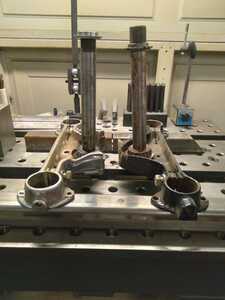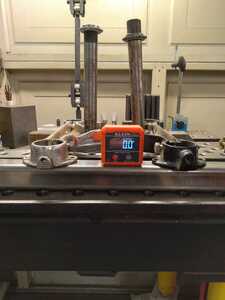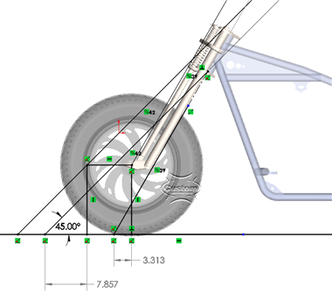Harley sidecar handling.
I currently ride a 1969 ElectraGlide with sidecar. Harley outfitted bikes, into the late 70's I believe, with adjustable trail front fork stems to allow easier steering with the sidehack attached. Also the fork stem had an adjustable steering damper to help suppress low speed wobble.
Today, I am thinking of adding a sidecar to my 97 FLHP. Harley no longer made adjustable forks for these, but still did offer factory sidecars.
Does anyone out there have experience riding the older style like my 69, and also the newer style like my 97, to compare contrast handling between the two eras?
This kind of question is exactly why we do forums!
Illegitemi non carborundum est!
I'm sure he will find your answer very helpful, Mr Lewis
I've driving all of them, the 97 would be day and night being a lot better. But depends on what and how you plan on using it for local on traveling long distance trips. The 69 looks better than the 97 IMO, but the 97 would be less strain on you.
One of my sidecars is my old -89 Softail Custom: I replaced the 21in front wheel by a 16 (on the advice of different "gurus"), bought some nice raked custom
triple trees, longer fork and a damper. The old Evo (68K miles) is still happy pulling the California Companion GT and is not too heavy in the twisties.
If you are use to riding your 69 and have no problem. Then I would not worry about changing the trees on the 97 The first couple of year I didn't have a steering damper it. The first real test I've done to see if I like it was riding it down the Blue Ridge plus in one day just around 500 miles and that was a long day.
The trees are much different between the 69' and the 97'. On the left is the standard lower tree from my 72' FLH (not the adjustable tree fitted to side car bikes) the fork is forward of the stem, no rake in the stem, and the frame had 30 Degrees of rake. Thus the need for adjustable trees and a damper for chassis tuning. When elevated for a steering head adjustment, the natural position of the wheel is full lock to either side.
On the right is the lower tree from a 98' touring model. The fork is to the rear of the stem, the stem is raked at about 5 degrees, and the frame had 26 degrees of rake. When elevated, the natural position of the wheel is straight ahead. Harley started using this design on the first rubber mounted touring chassis in 80'. This design decreased the steering effort, and improved handling, as the new platform was much heavier than the old.
The last pic is my 04' FLHT which shows the newer style trees.
Posted by: @2FLTCIf you are use to riding your 69 and have no problem. Then I would not worry about changing the trees on the 97 The first couple of year I didn't have a steering damper it. The first real test I've done to see if I like it was riding it down the Blue Ridge plus in one day just around 500 miles and that was a long day.
Thanks 2FLTC,
I have no issues guiding the 69. Good to hear the 97 will be at least as easy! Most of my riding is local, and Indiana is "mostly" flat ![]()
Harley did it a little different there for sure.
The main important measurements here are the angle of the steering head/stem.
The angle of the rake in relation to the headstem.
The distance fore or aft between the top of the headstem and the top triple tree.
Then what these combinations produce in trail figures at the axle.
And it's that trail figure that ultimately determines ease of steering a rig at speed in cross winds, curves and cambered roads.
For sure it can be set to run straight on a flat straight road when such a thing is available.
The but is when it is not.
Had a brief look for diagrams but most searches showed chopper type extremes.
Here's one for the sake of confusion.
Maybe someone has diagrams specific to Harley's touring bikes where the fork line is raked different to the headstem and start behind the headstem.
What I would like to see is the overall picture and not potentially misleading details.
(@brstr) rbracing-rsr.com, They are engineers, so pictures aren't plentiful, but the math is there. Harley specific. Many calculators available.
Posted by: @not-bobThe trees are much different between the 69' and the 97'. On the left is the standard lower tree from my 72' FLH (not the adjustable tree fitted to side car bikes) the fork is forward of the stem, no rake in the stem, and the frame had 30 Degrees of rake. Thus the need for adjustable trees and a damper for chassis tuning. When elevated for a steering head adjustment, the natural position of the wheel is full lock to either side.
On the right is the lower tree from a 98' touring model. The fork is to the rear of the stem, the stem is raked at about 5 degrees, and the frame had 26 degrees of rake. When elevated, the natural position of the wheel is straight ahead. Harley started using this design on the first rubber mounted touring chassis in 80'. This design decreased the steering effort, and improved handling, as the new platform was much heavier than the old.
The last pic is my 04' FLHT which shows the newer style trees.
-- attachment is not available --
-- attachment is not available --
-- attachment is not available --
Chris,
Glad to see several folks with knowledge of both eras here. Are you saying the fixed tree design of the 80 up FLs provides better handling with a sidecar, than the previous adjustable rake trees of the 60s-70s set to sidecar and not Solo position? This correlates with 2FLTCs opinion.
I do plan on running the -83 steering damper. You guys are boosting my confidence. I kinda figured Harley wouldn't do worse than the 70s and earlier design, but no longer offering specific forks for sidecars made me wonder how that was achieved.
Posted by: @brstrHarley did it a little different there for sure.
The main important measurements here are the angle of the steering head/stem.
The angle of the rake in relation to the headstem.
The distance fore or aft between the top of the headstem and the top triple tree.
Then what these combinations produce in trail figures at the axle.
And it's that trail figure that ultimately determines ease of steering a rig at speed in cross winds, curves and cambered roads.
For sure it can be set to run straight on a flat straight road when such a thing is available.
The but is when it is not.
Had a brief look for diagrams but most searches showed chopper type extremes.
Here's one for the sake of confusion.
Maybe someone has diagrams specific to Harley's touring bikes where the fork line is raked different to the headstem and start behind the headstem.
-- attachment is not available --
What I would like to see is the overall picture and not potentially misleading details.
Yeah, I've studied the geometries before, but at this point my engineering curiosity has waned and taken over by the desire to simply ride. I understand the leading link front end on my 99 Super X would probably make it a good sidehack tug, but that's not the focus today ![]()
Engineers are great and they do calcumalations really well.
My background is in fabrication.
Usually with paper drawings pre computer age.
And if it was tricky we drew it out on the floor.
Even after CAD became normal it was sometimes better to get on the floor.
On site it was not uncommon to sort an issue for the builder/architect/engineer.
So it is still good to get the overall picture for most of us.
Why is it that Harleys often seem to need major alterations to make them suitable for a sidecar ?
(@panhead_kicker) I will definitely defer to 2FLTCs experience here. While I have several 100k miles riding two wheeled Harleys, my sidecar piloting experience is minimal, and all on later model rigs.
- 29 Forums
- 11.8 K Topics
- 92.3 K Posts
- 7 Online
- 5,521 Members



